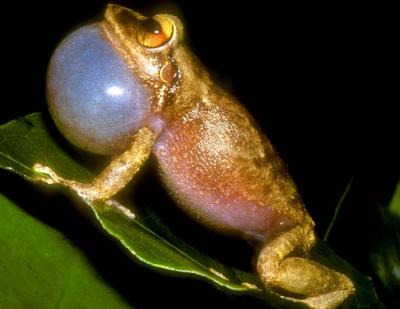Climate change a likely culprit in coqui frog's altered calls, say UCLA biologists

This is the coqui frog (Eleutherodactylus coqui) of Puerto Rico. Credit: Dante Fenolio
Authored by Peter Narins, UCLA distinguished professor of integrative biology and physiology and of ecology and evolutionary biology, and Sebastiaan Meenderink, a UCLA physics researcher, the study examined 170 male coqui frogs (Eleutherodactylus coqui) in 1983 and then 116 males in 2006. The study included frogs found at 28 altitudes in Puerto Rico, ranging from about 10 yards above sea level to more than 1,100 yards above sea level.
The study, the first to show the effect of temperature change on a species of frogs in the tropics over a period of more two decades, was published online April 9 in the journal Proceedings of the Royal Society B, and will appear later in the print edition.
“We think the animal adapted to temperature change by becoming smaller, which we believe causes the differences in their calls,” said Meenderink, who was previously a postdoctoral scholar in Narins' laboratory. The male's call is significant because it is used to attract females and to defend territory from other males.
Narins, who has studied the coqui for 41 years, said although the change is not very large, it is statistically significant and may well be a sign of difficult years ahead for the animal. The coqui is so beloved in Puerto Rico that it is the subject of songs and children's stories there.
Now, because of climate change, its reproductive success is likely to decrease substantially, the scientists predict.
“If current trends continue unabated, the coqui frog will sound and look quite different before this century is over,” said Narins, a faculty member in the UCLA College of Letters and Science.
The scientists found that frogs at comparable altitudes are more than 10 percent smaller in length than they were 23 years earlier. Using data from four weather stations in Puerto Rico, the researchers also learned that the temperatures increased by almost 0.5 degrees Fahrenheit over that time. Although that amount of warming doesn't sound like much, it is meaningful over such a brief period of time. If it continues or worsens in coming decades, it could be very dangerous for the coqui, whose existence dates back more than 11,000 years, and perhaps much longer than that.
According to Narins, some 30 percent of the world's more than 6,300 species of frogs and toads are endangered for a variety of reasons including climate change, chemical contamination of the water supply, destruction of their habitats and exposure to deadly fungi. In addition to their own intrinsic value, many of the species are important because scientists can study them to discover new treatments for disease. That opportunity would be lost if the animals become extinct.
In addition, the changes affecting the coqui could have an adverse effect on Puerto Rico's food chain, because owls, snakes, land crabs and other animals dine on the animal.
The research was funded by the National Institutes of Health (grant R01DC00222), the UCLA Academic Senate and the Netherlands Organisation for Scientific Research (grant NWO-VENI 863.08.003).
Media Contact
More Information:
http://www.ucla.eduAll latest news from the category: Life Sciences and Chemistry
Articles and reports from the Life Sciences and chemistry area deal with applied and basic research into modern biology, chemistry and human medicine.
Valuable information can be found on a range of life sciences fields including bacteriology, biochemistry, bionics, bioinformatics, biophysics, biotechnology, genetics, geobotany, human biology, marine biology, microbiology, molecular biology, cellular biology, zoology, bioinorganic chemistry, microchemistry and environmental chemistry.
Newest articles

Properties of new materials for microchips
… can now be measured well. Reseachers of Delft University of Technology demonstrated measuring performance properties of ultrathin silicon membranes. Making ever smaller and more powerful chips requires new ultrathin…

Floating solar’s potential
… to support sustainable development by addressing climate, water, and energy goals holistically. A new study published this week in Nature Energy raises the potential for floating solar photovoltaics (FPV)…

Skyrmions move at record speeds
… a step towards the computing of the future. An international research team led by scientists from the CNRS1 has discovered that the magnetic nanobubbles2 known as skyrmions can be…





















